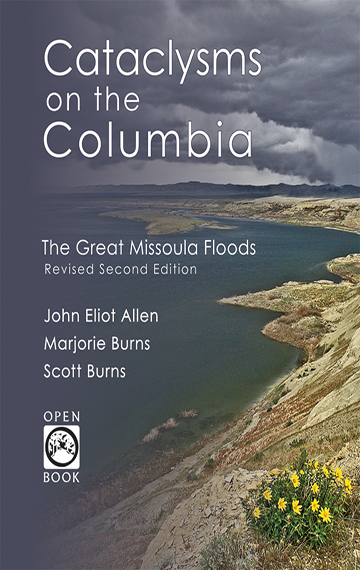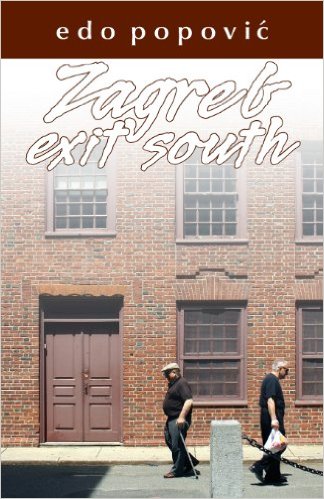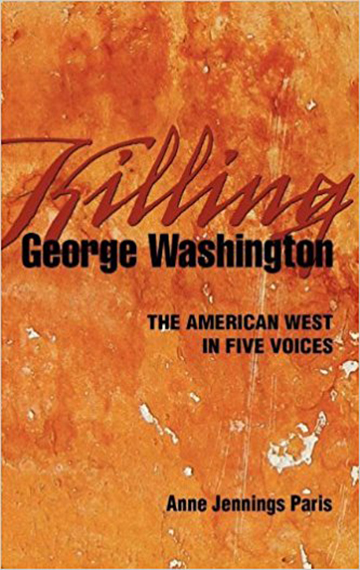Cataclysms on the Columbia tells two stories. One follows geological research that challenged the scientific paradigm of the early 20th century, and the other chronicles the results of that research: the discovery of powerful prehistoric floods that shaped the Pacific Northwest. The last Ice Age left scabland buttes, dry falls, and old river channels in its wake, but it took the detective work of geologist J. Harlen Bretz to prove it to the world. With a lifetime of research and an unshakeable belief, Bretz made history and changed geology forever.
A technical bibliography for Cataclysms is available here.
Praise for Cataclysms on the Columbia
“The book also tells a human story as fascinating as the story of the flood…entertaining and admirably clear.” — Margaret Donsbach, “Friends of the Columbia River Gorge Bulletin”
Media
Marjorie Burns gives a talk about authoring the book (Youtube)
Kboo radio interview with Professor Scott Burns
Reviews
Imagine floodwater in places a thousand feet deep, moving nine cubic miles of water per hour at freeway speeds, emptying an enormous ice-dammed Montana lake into the Pacific Ocean in a week. The turbulent turmoil, witnessed by no doubt awed humans, shaped much of the landscape in the Pacific Northwest, though J.Harlen Bretz had a tough time convincing his fellow geologists of that. He lived long enough to savor victory over the academic establishment. Here’s the story of what are now known as the Bretz Floods, complete with (unfortunately fuzzy) photographs, maps, and a tour guide so you go see — and comprehend — the results for yourself. Scientific sleuthing at its best.
* In the middle of the debate proceedings, Joseph Thomas Pardee, a geologist who was personally familiar with much of Bretz’s terrain, reportedly turned to his friend, Kirk Bryan, and confided the following small but significant message, “I know where Bretz’s flood came from.”
Now there was a puzzle! If, in fact, Pardee knew the source of Bretz’s water, why was he unwilling to make it known? The very nature of scientific advancement — so we are told — demands openmindedness and a chance to build on one another’s discoveries, and yet Pardee was to remain silent on the issue for more than a decade. The explanation was simple enough: Pardee had a career and a reputation to maintain. It was risky for any geologist to show hint of support for Bretz’s offensive hypothesis; and, to add to the problem, Pardee worked for W. C. Alden, the champion of scientific hesitancy.
* Gravel bars build and move downstream during floods by the top material rolling downstream in the current and spilling over the steep lower end of the bar. Eventually, each bar is thus composed of beds that slope steeply in a downstream direction. These foreset beds are found along the sides of canyons tributary to the main river, and they dip in an opposite direction from what is normally the tributary stream’s main current; in other words, they dip upstream, a clear indication that flood waters rushed up these tributaries and dumped part of their load.
For Teachers
Provide students with the opportunity to learn about the exciting history of scientific discovery and debate in the Pacific Northwest with Cataclysms on the Columbia. Explore the legacy of J. Harlen Bretz, a geologist whose controversial theories regarding the formation of the Columbia River Gorge challenged the traditional beliefs and scientific paradigms of early 20th century scientists. Through skillful research and endless determination, Bretz’s discoveries proved to the world that the powerful prehistoric Missoula Floods shaped the landscape of the Pacific Northwest. In addition to detailing Brentz’s journey of discovery and his fight for accreditation, Cataclysms on the Columbia includes the history of the regional landscape and a geological travelogue describing features from central Montana to the Pacific Ocean. Cataclysms on the Columbia is a valuable resource for learning about the nature of scientific debate and the difficulties involved when challenging established theories.
Grades: 10-12, College
Topics: Earth Science, Regional Geological History, Scientific Theory/Debate, Formation of the Columbia River Gorge, Missoula Floods







